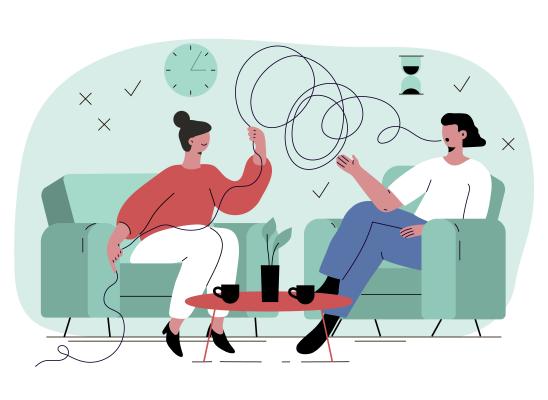Self-Help Manuals for BFRBs: Can They Help?

Online test
Find out the severity of your symptoms with this free online test
When we think of treatments for body-focused repetitive behaviors (BFRBs) like hair pulling, we typically think of someone being treated by a therapist using Habit Reversal Therapy (HRT). In fact, HRT is considered the gold standard for the treatment of BFRBs and is most often conducted by a therapist as part of the treatment process.
It’s fairly common for people with mental health issues of all kinds to seek out self-help resources. In fact, it’s been estimated that as much as 75% of people with mental health issues will attempt to work through them on their own before seeking professional help. Some may never seek professional help or prefer self-help. Self-help is sometimes used in place of therapy. Self-help can also be used as part of a larger treatment plan. Studies have found that self-help resources can be an effective tool in the management of a number of mental health issues including anxiety and depression, and OCD.
Despite the prevalence of BFRBs, self-help for BFRBs such as hair pulling or skin picking has not been widely studied. A new study takes a closer look at self-help and whether it might be helpful for people dealing with a BFRB. Given the current approaches to treatment, the results might surprise you.
The Study
Participants in the study were people ages 16 and older who had one or more self-reported BFRB such as hair pulling, skin picking, nail-biting, or cheek biting.
The study specifically looked at the usefulness of self-help manuals based on one of three self-help protocols:
Decoupling (DC)
Decoupling in sensu (DC-is)
Habit Reversal Training (HRT)
While normally conducted with a therapist, the researchers developed a self-help HRT protocol using essential elements of the HRT process including awareness and competing response training.
Decoupling (DC) is the “unhooking” or separation of the various elements of undesirable behavior and associating them with new responses. It doesn’t necessarily replace the behavior as one might see with competing responses. Instead, decoupling replaces the unwanted behavior, skin picking for example, with behavior that mimics or simulates the unwanted behavior that is then diverted. The goal is to divert the behavior and to create a deterrent or barrier to the automatic BFRB so that the undesired behavior can be detected early enough to allow the person to intervene.
Decoupling in sense (DC-is) is similar to the decoupling sequence but is performed to a significant degree via imagining the actions. The person imagines different actions or movements that typically precede the BFRB. Just prior to engaging in the BFRB, the imagined movement is halted by an actual movement. In short, the imagined undesired behavior is blocked by a behavioral counter-response.
The Results
The study found support for the use of self-help manuals for treating BFRBs. Participants who used the decoupling protocol reported symptom improvements of 35% as compared to 10% for the HRT group and 23% for the DC-is group. DC seemed to work best for non-skin-pickers.
An additional contribution of the study was the introduction of a new tool for the assessment of BFRBs. Generic Body-Focused Repetitive Behavior Scale. The GBS is used to assess the severity and impairment associated with different forms of BFRBs. There is no gold standard tool for assessing BFRBs so this is an exciting addition to the toolbox!
While the findings don’t support replacing current evidence-based treatments for BFRBs, they do suggest that self-help has the potential to help people who struggle with BFRBs.
A Place for Self Help
Of course, self-help alone may not be enough for someone with severe BFRB symptoms or other mental health needs that require the support of a therapist. For others, however, self-help tools may be a courageous first step, an acceptable non-clinical option, or a great addition to one’s therapeutic plan.
Self-help offers advantages for the person and potentially for the course of treatment:
An alternative to traditional therapy – Some people are understandably hesitant to seek out traditional therapy for any number of reasons. Having self-help resources gives them a tool for addressing their symptoms using research-supported tools and protocols. For some people with mild symptoms, sometimes self-help can be enough.
Flexibility – Self-help tools are generally user-friendly and meant to be used at the person’s convenience.
Familiarity and Acceptance – If the number of self-help tools and the number of people using them are any indications, then people seem to generally trust and value self-help tools. And, when you find value in something, you’re more likely to use it.
Accessibility – for some people, accessing treatment for their BFRB is difficult. Whether it’s geography, finances, mobility or time, trying to see someone in a traditional therapy setting can be a challenge. Self help can bridge that gap.
Therapy enhancement – For people in more traditional therapeutic programs, the addition of a self help can enhance the development of new skills and provide additional growth opportunities outside of the therapy room.
Of course, not all self-help tools are created equally. When considering self-help, you have to do your homework. A way to remember to ask the right questions is to R.E.S.T.
- Is the self-help tool based on sound Research?
- What is the Expertise of the person or program recommending the self-help tool?
- Does the tool seem to be Self-applicable? In other words, is it user-friendly?
- How Trustworthy is the source of the self-help tool?
While self-help has become quite popular for managing other mental health issues, it is just emerging as a possible tool for helping people living with BFRBs. What is clear is that people living with mental health issues like BFRBs tend to be receptive to self-help strategies and eager to find solutions. Early research results are promising, and self-help tools may become a standard part of the BFRB treatment process.
References
1. Falbe-Hansen, L., Le Huray, C., Phull, B., Shakespeare, C., & Wheatley, J. (2009). Using guided self-help to treat common mental health problems: The Westminster Primary Care Psychology Service. London journal of primary care, 2(1), 61–64. https://doi.org/10.1080/17571472.2009.11493246
2. Moritz, S., Jelinek, L., Hauschildt, M., & Naber, D. (2010). How to treat the untreated: effectiveness of a self-help metacognitive training program (myMCT) for obsessive-compulsive disorder. Dialogues in clinical neuroscience, 12(2), 209–220. https://doi.org/10.31887/DCNS.2010.12.2/smoritz
3. Pillay, S. (2017, February 2). When are self-help programs “helpful”? Retrieved from https://www.health.harvard.edu/blog/self-help-programs-helpful-2017020211069
Online test
Find out the severity of your symptoms with this free online test
Start your journey with TrichStop
Take control of your life and find freedom from hair pulling through professional therapy and evidence-based behavioral techniques.
Start Now



